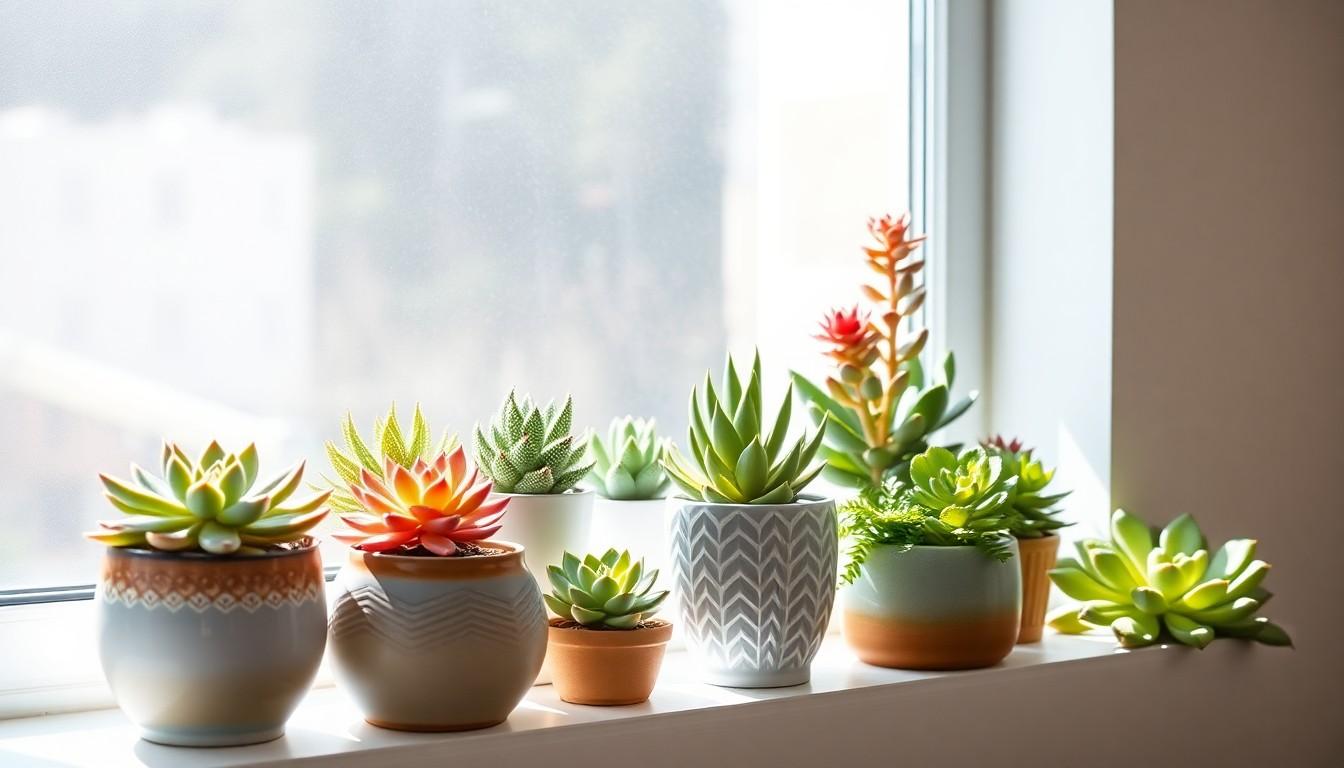Succulents have taken the plant world by storm, and it’s easy to see why. With their quirky shapes and vibrant colors, they’re like the cool kids of the botanical family. But the real question is: are they as low-maintenance as they claim to be? Spoiler alert—they’re not just pretty faces.
Caring for succulents can feel like a walk in the park, or a stroll through a desert, depending on how you look at it. They thrive on neglect, making them the perfect companions for anyone who’s ever accidentally turned a houseplant into a science experiment. If you’ve been wondering whether you can handle the responsibility of these delightful little green wonders, you’re in for a treat. Let’s dive into what it really takes to keep these beauties alive and flourishing.
Overview Of Succulents
Succulents are water-retaining plants known for their thick, fleshy leaves and stems. They’ve become popular in various settings, from homes to offices, due to their striking appearance and low water needs. Varieties include jade plants, aloe vera, and echeveria, each possessing unique shapes and colors.
These plants thrive in arid environments, having adapted to store water in their tissues. Many people believe they require minimal care, often associating them with a carefree gardening experience. However, succulents still need specific conditions to flourish. Light exposure plays a crucial role; most prefer bright, indirect sunlight.
Soil selection significantly impacts their growth. A well-draining potting mix, such as cactus soil, prevents root rot. Overwatering poses a common threat, making it essential to allow the soil to dry before the next watering. Additionally, temperatures above 60°F (15°C) generally encourage healthy growth.
Fertilization enhances succulents’ vitality. A balanced fertilizer diluted to half strength, applied during the growing season, supports their development. Pests, such as mealybugs and aphids, can affect their health, requiring careful monitoring and treatment when necessary.
Propagation offers an exciting way to expand a succulent collection. Cuttings from healthy plants can root easily in soil or water. Choosing the right time for propagation typically ensures successful results, particularly in spring or early summer.
Overall, while succulents are relatively easy to care for, they do demand attention to specific factors. Understanding their needs ensures success in maintaining vibrant and healthy specimens.
Key Factors In Succulent Care

Successful succulent care hinges on several essential factors. Attention to light, watering, and soil type influences plant vitality and growth.
Light Requirements
Adequate light is crucial for succulents’ health. Bright, indirect sunlight serves as the ideal condition for most varieties. Some species, like jade plants, can thrive in direct sun, while others prefer filtered light. Placement near a south or west-facing window generally works best. Insufficient light may lead to leggy growth or color fading. Some growers choose to rotate their plants occasionally to ensure even exposure.
Watering Needs
Effective watering practices significantly impact succulent wellness. These plants prefer infrequent watering, allowing the soil to dry completely between sessions. Generally, a deep soak every two to four weeks suffices, but this may vary with temperature and humidity. Signs of overwatering include yellowing leaves or soft, mushy stems. Conversely, underwatering leads to shriveling leaves. Observing the plant’s condition guides optimal watering routines.
Soil Type
Proper soil type enhances drainage and prevents root rot. Using a well-draining succulent mix is essential, often containing a combination of potting soil, sand, and perlite. Commercially available cactus and succulent blends work effectively. Custom mixes can offer additional control over moisture retention. Avoid heavy soils that retain excess moisture, as this can hinder succulent health. Selecting the right container with drainage holes further ensures that roots stay dry.
Common Mistakes In Succulent Care
Succulents require specific care, and common mistakes can hinder their growth and vitality.
Overwatering
Overwatering serves as a primary mistake in succulent care. Many plant owners misjudge the watering frequency, assuming more water leads to better health. Soil moisture levels should dictate the watering schedule instead. Succulents prefer dry conditions, thriving when the soil dries out completely between waterings. Root rot often arises from overly saturated soil, resulting in mushy stems and leaves. It’s crucial to establish a routine that factors in environmental conditions, such as temperature and humidity. Monitoring the plant’s appearance also aids in understanding water needs. Signs like wrinkled or shriveled leaves indicate insufficient water, while yellowing signals overwatering.
Poor Soil Drainage
Poor soil drainage creates significant challenges for succulents. Choosing the right soil mix directly impacts their health. Cacti and succulent mixes contain grit that promotes drainage, essential for preventing root rot. Standard potting soil usually retains too much moisture, which succulents can’t tolerate. Ensuring pots have drainage holes also enhances airflow and moisture control. If using decorative pots without holes, consider placing succulents in pots first and then into decorative containers. Mixing perlite or pumice into the soil can improve drainage further. Proper soil drainage allows roots to access oxygen, fostering robust growth and vibrant foliage.
Benefits Of Keeping Succulents
Succulents offer numerous advantages that make them an attractive choice for indoor and outdoor gardening. Easy care stands out as a primary benefit. These plants tolerate neglect well, allowing flexibility for busy lifestyles.
Low water requirements contribute to their appeal. Succulents can thrive in arid conditions, needing infrequent watering, typically every two to three weeks. This characteristic suits individuals who may forget regular watering schedules.
Moreover, succulents enhance air quality. Plants like aloe vera purify the air by removing harmful toxins, promoting a healthier living environment. This makes them ideal for homes and workplaces.
Aesthetically, vibrant colors and unique shapes provide visual interest. Varieties such as echeveria and jade plants add diverse textures, enhancing interior design. Their resilience ensures that they remain beautiful even with minimal care.
In addition, succulents promote mental well-being. Interacting with plants can reduce stress, improve mood, and increase productivity. Gardens, whether indoor or outdoor, serve as calming spaces conducive to relaxation.
Propagation adds another layer of enjoyment. Taking cuttings from healthy plants fosters an engaging gardening experience. It also provides opportunities to share with friends or diversify one’s plant collection.
Lastly, their compact size makes succulents suitable for small spaces. Individuals living in apartments or tight quarters can easily incorporate them into decor without overwhelming limited areas.
Overall, succulents offer low maintenance, enhance aesthetics, improve air quality, and promote mental health, making them an invaluable addition to any home or garden.
Conclusion
Succulents offer a unique blend of beauty and resilience that appeals to many plant enthusiasts. While they’re often seen as low-maintenance plants, they do require specific care to truly thrive. Understanding their needs for light, watering, and soil type is crucial for keeping them healthy.
By providing the right conditions and avoiding common mistakes, anyone can enjoy the vibrant colors and unique shapes of succulents in their home. Their ability to enhance interior spaces and promote mental well-being makes them a worthwhile addition to any collection. With a little attention, succulents can bring joy and life to any environment.

